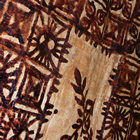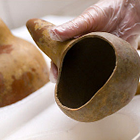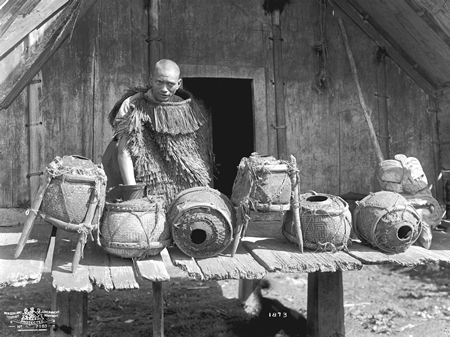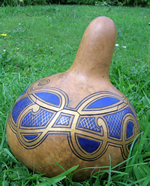This page is an archive of previous research projects (and, as such, is not actively maintained). For current research, go here.
Ethnobotany and Dispersal of Paper Mulberry in Polynesia
 |
Research on paper mulberry (Broussonetia papyrifera) is being carried out in collaboration with Andrea Seelenfreund at the Universidad Academia de Humanismo Cristiano and Daniela Seelenfreund at the Universidad de Chile.
Paper mulberry is native to Japan and Taiwan, and its initial dispersal into the Pacific is thought to be associated with the Austronesian expansion. In Polynesia, the bark of paper mulberry was (and is) used to make tapa cloth (shown at left). Paper mulberry was dispersed as far as Hawai‘i, Easter Island and New Zealand in the pre-European era.
Using DNA fingerprinting techniques we are reconstructing the dispersal of paper mulberry across the Pacific. Dispersal patterns of paper mulberry should mirror patterns of human migration and mobility (trade/interaction) in the Pacific.
For information on the Universidad Academia de Humanismo Cristiano’s research on Chilean Islands (including Easter Island/Rapa Nui) click here (in Spanish).
People
Andrea Seelenfreund — Universidad Academia de Humanismo Cristiano, Santiago, Chile
Daniela Seelenfreund — Universidad de Chile, Santiago, Chile
Sergio Lobos — Universidad de Chile, Santiago, Chile
Lisa Matisoo-Smith — University of Otago, Dunedin, New Zealand
Naria Oyanedel Giaverini — Universidad de Chile, Santiago, Chile
Resulting Publications
Seelenfreund, D., Clarke, A. C., Oyanedel, N., Piña, R., Lobos, S., Matisoo-Smith, E. A., and Seelenfreund, A. 2010. Paper mulberry (Broussonetia papyrifera) as a commensal model for human mobility in Oceania: anthropological, botanical and genetic considerations. New Zealand Journal of Botany 48: 231–247.  |
Genotype to Phenotype Research in Onion
 |
Research on onion (Allium cepa) is being carried out in collaboration with John McCallum at Plant & Food Research, and has been focussed in two areas:
| |
|
| 1. |
Understanding the genetic basis for the wide variation observed in relative amounts of onion dry matter (fructose, glucose, sucrose and fructans).
By combining phenotype data (bulb carbohydrate composition) with genetic data (SSRs, AFLPs and QTL analysis) a genetic locus (Frc) was located that may account for the major phenotypic differences in bulb carbohydrate content between storage and sweet onion varieties. Read the Crop & Food news story here. |
| |
|
| 2. |
Using microsatellite markers (or SSRs to understand the structure of genetic variation within and among onion populations.
Analyses of genetic distances among populations allowed long-day, short-day, and Indian populations to be distinguished. Resequencing of marker amplicons allowed the development of five SNP assays for purity testing of inbreds and other applications in Allium genetics. |
Future work may focus on understanding onion genes under human selection.
People
John McCallum — Plant & Food Research, Lincoln, New Zealand
Resulting Publications
McCallum, J., Thomson, S., Pither-Joyce, M., Kenel, F., Clarke, A., and Havey, M. J. 2008. Genetic diversity analysis and single-nucleotide polymorphism marker development in cultivated bulb onion based on expressed sequence tag-simple sequence repeat markers. Journal of the American Society for Horticultural Science 133: 810–818. 
McCallum, J., Clarke, A., Pither-Joyce, M., Shaw, M., Butler, R., Brash, D., Scheffer, J., Sims, I., van Heusden, S., Shigyo, M., and Havey, M. J. 2006. Genetic mapping of a major gene affecting onion bulb fructan content. Theoretical and Applied Genetics 112: 958–967. 
McCallum, J., Pither-Joyce, M., Clarke, A., Kik, C., Van Heusden, S., Jakse, J., and Havey, M. J. 2005. Towards a framework PCR-based map of onion (Allium cepa L.). In Liu, G. (Ed.), Proceedings of the Fourth International Symposium on Edible Alliaceae, Beijing, China, 21–26 April, 2004, pp. 173–178. Acta Horticulturae 688. International Society for Horticultural Science: Leuven, Belgium.  |
Origins of the Polynesian Bottle Gourd (Hue)
 |
The bottle gourd (Lagenaria siceraria) was domesticated by at least 10,000 yr BP (years before present), making it one of the first plant species cultivated by humans. Its versatile fruits (calabashes) also helped make it one of the most widespread, and by 2000 BC it was grown by peoples in Africa, Asia and the New World (North and South America).
 |
| Pai Kanohi with tahā huahua bottle gourd containers for preserving kererū (wood pigeons), Ruatahuna, New Zealand, 1903. |
Current research is focussed in two areas:
| |
|
| 1. |
Determining the origin of the Polynesian bottle gourd.
The bottle gourd was grown by Polynesians by at least AD 1000, but how, when, and from where this species entered the Pacific is only partially resolved. One hypothesis we are testing is that the Polynesian bottle gourd is of South American origin; like the sweet potato, it may have been introduced from South America by Polynesian voyagers. |
| |
|
| 2. |
Developing a model for the domestication(s) and global dispersal of the bottle gourd. |
| |
 |
| |
Bottle gourd carved with modern Māori design. |
For both these areas, we are carrying out molecular (DNA) analysis on a range of modern material.
Molecular data are being integrated with existing archaeological, linguistic and morphological data where possible.
People
David Penny — Massey University, Palmerston North, New Zealand
Roger Green — University of Auckland, Auckland, New Zealand
Dave Erickson — National Museum of Natural History, Smithsonian Institution, Washington, DC, United States
Mike Burtenshaw — Open Polytechnic of New Zealand, Lower Hutt, New Zealand
Resulting Publications
Clarke, A. C., Burtenshaw, M. K., McLenachan, P. A., Erickson, D. L., and Penny, D. 2006. Reconstructing the origins and dispersal of the Polynesian bottle gourd (Lagenaria siceraria). Molecular Biology and Evolution 23: 893–900. 
Erickson, D. L., Smith, B. D., Clarke, A. C., Sandweiss, D. H., and Tuross, N. 2005. An Asian origin for a 10,000-year-old domesticated plant in the Americas. Proceedings of the National Academy of Sciences of the United States of America 102: 18315–18320. 
|
|